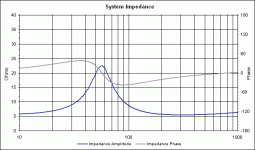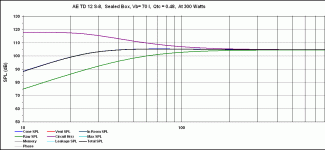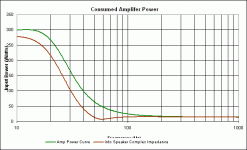I used second order electric (fourth order acoustic) high pass on the HM100Z0.
The Monacor isn't anything like the Audax DT101. The Audax was a flat plate Ti dome. I think they were made by JBL.
The Monacor isn't anything like the Audax DT101. The Audax was a flat plate Ti dome. I think they were made by JBL.
The specs were on AE'S website and just disappeared. Thanks for your suggestions. I already have the TD12S woofers so I would like to use them.
Still, you have a fair shot with TD 12 S-8.
In a 70 litre sealed box with 13 dB Linkwitz transform gain.
(Fo=53Hz; Qo=0,48; Fp=25Hz;Qp=0,7)
F3/F6/F10=27/20/15Hz
In a 70 litre sealed box with 13 dB Linkwitz transform gain.
(Fo=53Hz; Qo=0,48; Fp=25Hz;Qp=0,7)
F3/F6/F10=27/20/15Hz
Attachments
The reason I have matched the db on my driver's is so we can design a passive crossover later after I get the minidsp to give me an idea of where to cross and delay etc... It's just easier when your drivers are about the same not as much padding down. Kepp the opinions coming great job of swapping thougjts!!!
Why not keep it bi-amped? Big coils and caps are expensive and much less ideal than a decent amp.
Still, you have a fair shot with TD 12 S-8.
In a 70 litre sealed box with 13 dB Linkwitz transform gain.
(Fo=53Hz; Qo=0,48; Fp=25Hz;Qp=0,7)
F3/F6/F10=27/20/15Hz
That's getting very dangerous! I run a 10" SEAS L26ROY in a sealed 30L box, downfire. Some findings by experience: (for dsp systems)
- first with no eq, measure acoustic performance in nearfield and at listening spot. You will see what speaker positioning and room modes are doing.
- be very careful with gain to avoid digital clipping in dsp process! Rather apply attenuation above say 40Hzin reverse (high/low shelf and +/- values total the same).
-measure distortion in nearfield with high output, look and use fingers to estimate excursion!
- Then also apply deep cut-off for subsonics below 15Hz especially if you have a vinyl turntable/RIAA without subsonic filter!
This way I got straight room response starting from 16Hz!
http://www.diyaudio.com/forums/atta...ect-ainogneob-v92-lr-60-vs-100cm-backw-13.png
Where are you guys
....Audax is from France... But it was a brand from the XX° century ! Some archeologists sometimes find a HM100ZO or a PR170ZO in USA! But Only Indiana Jones can find a HD-3P....
😀
There are a few firms that appear to sell them still, I have a couple if sources that say they have stock (not europeaudio, or teamaudio.fr)
There are a few firms that appear to sell them still, I have a couple if sources that say they have stock (not europeaudio, or teamaudio.fr)
I used the HM100Z0 in my three-way designs, along with the HM210Z0 bass and ScanSpeak D2905-9300.
The Audax mids are an excellent transparent driver, but have two features that make them hard to fit into most systems, particularly in a 3-way design. Their high sensitivity comes from their stiff suspension, which leads to a high resonance frequency of 250Hz, and this restricts the crossover frequency to at least 400-500 Hz. So you need to match them to a bass driver which is well-behaved at its upper end, and you are also best using a 4th (or higher) order crossover so as not to overload the midrange driver at the lower end of its frequency range.
The other awkward feature is that in a 3-way passive speaker there is a passive gain in the bandpass filter feeding the midrange, which may amount to over 3 dB. So the sensitivity of the midrange goes up from an already high 93 dB to 96 dB or more, making it really hard to find bass and treble drivers to match its sensitivity - otherwise you have to pad down the midrange by several dB, as I had to do.
The alternative is to use it in an active system, which presents very different challenges.
Alex
The Audax mids are an excellent transparent driver, but have two features that make them hard to fit into most systems, particularly in a 3-way design. Their high sensitivity comes from their stiff suspension, which leads to a high resonance frequency of 250Hz, and this restricts the crossover frequency to at least 400-500 Hz. So you need to match them to a bass driver which is well-behaved at its upper end, and you are also best using a 4th (or higher) order crossover so as not to overload the midrange driver at the lower end of its frequency range.
The other awkward feature is that in a 3-way passive speaker there is a passive gain in the bandpass filter feeding the midrange, which may amount to over 3 dB. So the sensitivity of the midrange goes up from an already high 93 dB to 96 dB or more, making it really hard to find bass and treble drivers to match its sensitivity - otherwise you have to pad down the midrange by several dB, as I had to do.
The alternative is to use it in an active system, which presents very different challenges.
Alex
- Status
- Not open for further replies.
- Home
- Loudspeakers
- Multi-Way
- Audax Hm100z0



